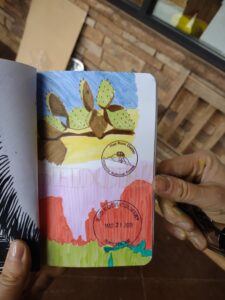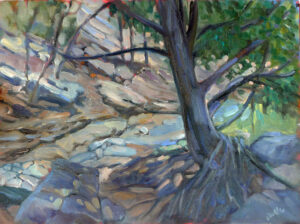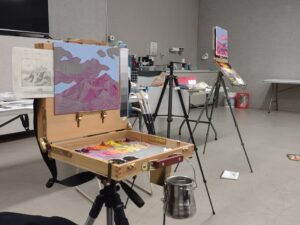I’m in Arizona, teaching an annual workshop for the Sedona Arts Center. This has been an unusual year for the west, with snow, rain and cold in spectacular amounts. Still, my stalwart and stoic students are pushing through it.
Yesterday, we painted under the ramada at the Red Rock District Visitor Center in Coconino National Forest. We watched low-hanging clouds play peek-a-boo with Bell Rock, Courthouse Butte, and the surrounding massifs. It poured steadily all day. The high desert struggles to absorb it, as evidenced by Dry Beaver Creek in the video above, shot by my monitor, Ed Buonvecchio. Normally, this is a dry wash. I am staying in a casita above a tributary of Dry Beaver Creek, and as I listen to the rain sheeting down the tiles of my roof this morning, I wonder if the road will hold.

The manager of the Visitor Center welcomed us. “We like to demonstrate that there are many ways to appreciate nature besides hiking,” she said. She mentioned that she took up watercolor sketching herself during the pandemic, and now hikes with a small portable paint kit and sketchbook.
“You see things differently when you’re hiking from when you’re standing still,” she told me. I’ve experienced this myself. I’ve had elk, small animals and birds come out of the forest near me.

It’s not what you see, it’s how you see
Mostly, it’s not what you see but how you see that changes. You start with the panorama, the ‘money shot,’ as we so blithely call it. The big, spectacular massifs catch your eye. But spend time standing still in the desert and other things begin to catch your attention: rock piled on rock, the smell of creosote bush, juniper and piñones on a hot day, or the play of light on a canyon wall.
Back up slowly through all the forms of locomotion, and think of how each one changes your perception. Hiking, you see detail, but in rocky terrain you spend much time checking your footing. In a jeep or four-wheeler, you’re moving slowly enough to appreciate the rise and fall of the land, but you’re never in one spot long enough to savor the subtle interplay of light and shadow. In a car, you see only the big picture.
Our roads and parks make nature accessible to everyone. That’s in contrast to the 19th century, where you had to be either rich or an adventurer to get back of beyond. I might bemoan the damage that off-roading does to the environment, but it makes it possible for people with mobility issues to get out into nature.
I love all four speeds of appreciating the environment: sketching, hiking, four-wheeling, and long drives. As a nation, however, we do way too much of the latter, and not enough of the former.

My late friend Helen lived in a run-down section of North Braddock, Pennsylvania, which is itself a clapped-out old steel town. Helen wasn’t very mobile, so she appreciated nature from her porch. There was an empty lot next door. Every spring, she’d send me pictures of the weedy scrub coming into bud and flower. She was still enough to see beauty where others just saw urban blight. Sometimes she’d send me a picture she’d painted using copy paper and a paint set she bought at Dollar General.
Be more like Helen, and you’ll start to see your world differently. “But I can’t draw!” you say. Helen didn’t let that stop her. When you were a child, you knew how to draw a flower. What made you lose confidence in your ability?
Reserve your spot now for a workshop in 2025:
- Advanced Plein Air Painting, Rockport, ME, July 7-11, 2025.
- Sea and Sky at Acadia National Park, August 3-8, 2025.
- Find Your Authentic Voice in Plein Air, Berkshires, MA, August 11-15, 2025.
- Immersive In-Person Fall Workshop, Rockport, ME, October 6-10, 2025.

Lovely, Carol. So beautifully done, so warming and caring. And inspiring.
Thank you.
Joan
Love that!